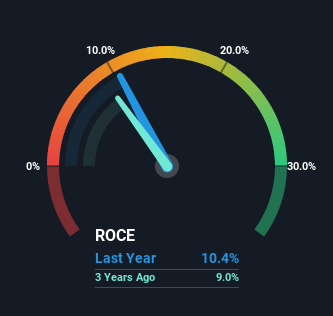Return Trends At John Wiley & Sons (NYSE:WLY) Aren't Appealing
If you're looking for a multi-bagger, there's a few things to keep an eye out for. One common approach is to try and find a company with returns on capital employed (ROCE) that are increasing, in conjunction with a growing amount of capital employed. Put simply, these types of businesses are compounding machines, meaning they are continually reinvesting their earnings at ever-higher rates of return. Although, when we looked at John Wiley & Sons (NYSE:WLY), it didn't seem to tick all of these boxes.
Return On Capital Employed (ROCE): What Is It?
For those who don't know, ROCE is a measure of a company's yearly pre-tax profit (its return), relative to the capital employed in the business. Analysts use this formula to calculate it for John Wiley & Sons:
Return on Capital Employed = Earnings Before Interest and Tax (EBIT) ÷ (Total Assets - Current Liabilities)
0.10 = US$226m ÷ (US$2.8b - US$610m) (Based on the trailing twelve months to October 2023).
So, John Wiley & Sons has an ROCE of 10%. On its own, that's a standard return, however it's much better than the 8.2% generated by the Media industry.
View our latest analysis for John Wiley & Sons
Above you can see how the current ROCE for John Wiley & Sons compares to its prior returns on capital, but there's only so much you can tell from the past. If you'd like, you can check out the forecasts from the analysts covering John Wiley & Sons here for free.
How Are Returns Trending?
Over the past five years, John Wiley & Sons' ROCE and capital employed have both remained mostly flat. This tells us the company isn't reinvesting in itself, so it's plausible that it's past the growth phase. So unless we see a substantial change at John Wiley & Sons in terms of ROCE and additional investments being made, we wouldn't hold our breath on it being a multi-bagger.
Our Take On John Wiley & Sons' ROCE
In summary, John Wiley & Sons isn't compounding its earnings but is generating stable returns on the same amount of capital employed. And investors appear hesitant that the trends will pick up because the stock has fallen 22% in the last five years. In any case, the stock doesn't have these traits of a multi-bagger discussed above, so if that's what you're looking for, we think you'd have more luck elsewhere.
Like most companies, John Wiley & Sons does come with some risks, and we've found 2 warning signs that you should be aware of.
While John Wiley & Sons isn't earning the highest return, check out this free list of companies that are earning high returns on equity with solid balance sheets.
Have feedback on this article? Concerned about the content? Get in touch with us directly. Alternatively, email editorial-team (at) simplywallst.com.
This article by Simply Wall St is general in nature. We provide commentary based on historical data and analyst forecasts only using an unbiased methodology and our articles are not intended to be financial advice. It does not constitute a recommendation to buy or sell any stock, and does not take account of your objectives, or your financial situation. We aim to bring you long-term focused analysis driven by fundamental data. Note that our analysis may not factor in the latest price-sensitive company announcements or qualitative material. Simply Wall St has no position in any stocks mentioned.

